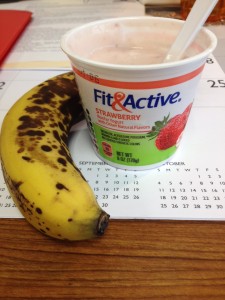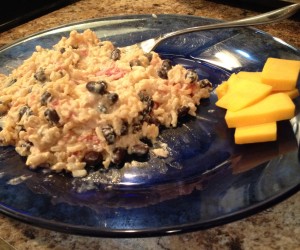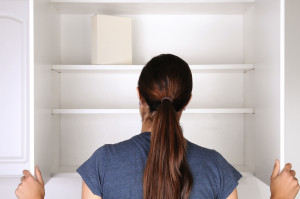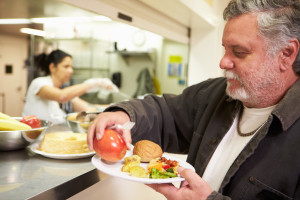The final day of the challenge arrived, Day 7. It started off the same as days 1-6, with yogurt. However, this day I had a whole 6oz. cup to eat. I also brought a very ripe banana to eat for breakfast as well. I didn’t end up getting to the banana until much later in the day. I had a busy morning,  so I ate my yogurt a little later than usual too, around 8:45a.m. The banana sat on my desk, looking at me all day with all of it’s spots.
so I ate my yogurt a little later than usual too, around 8:45a.m. The banana sat on my desk, looking at me all day with all of it’s spots.
I was definitely hungry once lunchtime rolled around. I had a fried egg on a toasted English muffin and a spinach salad with carrots, shredded cheese and Italian dressing. At lunch, I was asked by my coworkers what I was going to eat first once the challenge was over. When I first started this challenge I had the idea that I would eat a juicy cheeseburger with fries or a big home-cooked meal consisting of meat and potatoes. However, as the challenge moved along and approached its end, I didn’t want to look at it as something I had “won” or should receive a reward for. I put one small aspect of my life in the shoes of a S.N.A.P. recipient, someone who lives their life on a restricted budget every single day and they probably would not be having a celebratory meal.
The afternoon went by rather quickly and my usual light headache came creeping up on me again. When I got home from work I decided to eat what was left of  the cake. It was probably the last day for it anyway, it was starting to dry out. I thought the snack might hold me over for a while and I could eat a late dinner. While perhaps a good idea in theory, it didn’t really pan out.
the cake. It was probably the last day for it anyway, it was starting to dry out. I thought the snack might hold me over for a while and I could eat a late dinner. While perhaps a good idea in theory, it didn’t really pan out.
I ended up eating dinner around 6:30p.m. I had the leftover rice and bean dish I made the night before with the last few slices of cheese remaining from the block of cheese I had purchased. I was hoping this rice would hold me over for the remainder of the evening and would help my headache to go away. Again it was a good idea in theory, however around 7:45p.m. I found myself in the kitchen, cutting up the very last, very ripe banana that has spent the day with me at work. I put some peanut butter on the pieces and called it a snack. Thankfully eating the banana helped my headache to go away and I was no longer hungry.
I was surprised that I still had some food left at the end of this challenge. It wasn’t really anything substantial, rice and a few carrots and stalks of celery as well as 1/2 of a jar of peanut butter. If I were a S.N.A.P. recipient, I’m sure I would be happy to have these items rollover into the following week’s meals. I was able to correlate my frequent daily headaches and occasional stomach aches with a lack of sustenance. I also had difficulty focusing on tasks at work throughout the week as well. Having to deal with these symptoms day after day, month after month would surely take its toll on anyone.
 As my experiences with the S.N.A.P. Challenge came to a close, I started to feel guilty. I knew on Tuesday, my meals would go back to “normal” and the symptoms associated with hunger would subside. I felt most guilty because I knew that would not be the case for the millions of individuals who depend on S.N.A.P. or other assistance programs for their livelihood. The S.N.A.P. Challenge, for me, was a very small, eyeopening glimpse into the life of a S.N.A.P. recipient. I am sure my grocery shopping habits will change and I will be more conscious of my waste. The past week was nothing short of a learning experience for me.
As my experiences with the S.N.A.P. Challenge came to a close, I started to feel guilty. I knew on Tuesday, my meals would go back to “normal” and the symptoms associated with hunger would subside. I felt most guilty because I knew that would not be the case for the millions of individuals who depend on S.N.A.P. or other assistance programs for their livelihood. The S.N.A.P. Challenge, for me, was a very small, eyeopening glimpse into the life of a S.N.A.P. recipient. I am sure my grocery shopping habits will change and I will be more conscious of my waste. The past week was nothing short of a learning experience for me.
There is one area I know I haven’t touched upon in my previous posts and is something I have been thinking about constantly since beginning this challenge, I just didn’t know how to bring it up— the negative connotations society has associated with poverty and the individuals who receive assistance. There are glaring accusations and stereotypes of those who are in need of help. They have been called lazy and unmotivated, accused of “cheating the system” or “looking for a free handout.” There is the mindset of “why should my hard earned tax dollars go to support them when they don’t even have a job?”
Are there people who receive assistance who “abuse the system?” Sure there are, but that doesn’t make it fair to lump everyone who needs help into the same boat. You could say that about most anything. Since I am an animal lover, I’ll use an animal stereotype– “all pit bulls are vicious.” Without straying too far from the topic at hand, this breed is very misunderstood in the overall scheme of dog breeds. Can pit bulls bite and be mean? Sure, but any breed of dog can bite and be mean. What it narrows down to is the personality of the animal and what types of situations the owner puts them in. If the animal is known to not like other dogs, they probably shouldn’t take trips to the dog park. It simply isn’t fair to lump all pit bulls into the “vicious” category, yet society as a whole does. Unfortunately this happens with countless topics in the world, especially those related to poverty and support.
With poverty, there are many circumstances that could cause someone to turn to a food bank or the government for assistance– the breadwinner of the family left or passed away, there was an unexpected loss of income, a medical emergency arose and the bills have consumed all financial resources, a student fresh out of high school or college cannot find a job, the list goes on and on. There is no “right” or “wrong” need for food; food is a basic necessity that should be available to everyone.
There are many individuals out there who are juggling multiple part-time jobs as well as taking care of a family. This usually means they are without benefits, limited on time and resources. A good portion of this demographic is made up of single parents. They may need to pay for childcare, transportation to and from jobs– whether taking public transportation or purchasing gas for a vehicle (if they own a vehicle there is general maintenance to consider.) They will most likely have a monthly rent or house payment that will take away from their budget. There are countless other daily things  that may come about that would also pull from their monthly budget and hopefully no emergencies arise. Many of these individuals and families will utilize food distribution options offered through their local food bank.
that may come about that would also pull from their monthly budget and hopefully no emergencies arise. Many of these individuals and families will utilize food distribution options offered through their local food bank.
I know I touched on how hunger affects children earlier in the week. Just to briefly revisit the topic, this is a demographic that often gets overlooked when talking about the issues associated with hunger. The bottom line is that it is not the children’s fault their parent(s) must work multiple jobs to provide for them, they often don’t understand why their family doesn’t have enough money to provide them with everything they may need. They are at the mercy of others to provide for them. Second Harvest has programs in place to help alleviate child hunger in our region.
Another category of folks in need to consider is the elderly. Many of them are living off of a very fixed income and may need to use that income to purchase medications, pay bills, secure transportation for appointments; more times than not, food becomes the lowest priority on their list. Based off of the last Hunger Study, 17% of the population served by Second Harvest are over the age of 60; this equals 28,509 seniors. Through the federal government, Second Harvest is able to offer monthly boxes of food to qualifying seniors over the age of 60. The federal government regulates the number of boxes that can be distributed through the program; at this time Second Harvest distributes 2,587 boxes each month to eligible senior citizens with many more on a waiting list. Countless seniors also visit food pantries for meal items and soup kitchens for hot meals. A challenge with this demographic is that they may not have access to transportation or they may not  physically be able to leave their residence. They are then dependent on someone else to assist them.
physically be able to leave their residence. They are then dependent on someone else to assist them.
When I overhear someone talking negatively about assistance programs that are available in our region or those who rely on these programs, I can’t help but to get a little defensive. I know that their opinions probably stem from misinformation or a negative experience. It is my job, as well as the job of my coworkers, to provide our community with the correct information regarding hunger and the hungry in northwest Pennsylvania. Whether you have been following along with each of my posts or if this is the first post you have read, it is my hope that you have taken away at least a small piece of information that you may not have known before.
There are so many individuals, families, children and seniors in our community and throughout our country who rely on the services provided by food banks, pantries, shelters, soup kitchens and other relief organizations. They also rely on the voices who advocate for them. I encourage you to share these posts with your family and friends. If you are looking for ways you can get involved, please contact me at ajohnson@nwpafoodbank.org. If you or someone you know is in need of food assistance, please call Second Harvest at (814) 459-3663.
Thank you for reading along!
~Amanda
